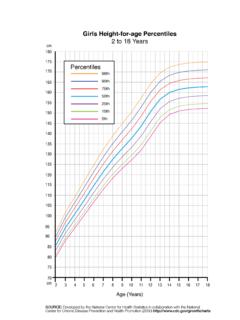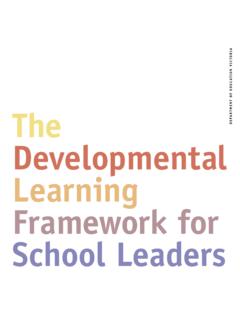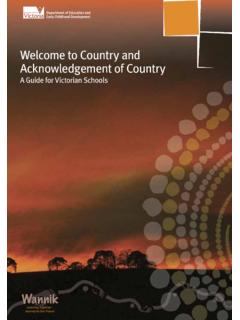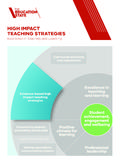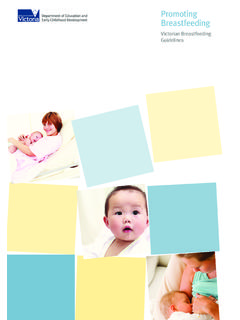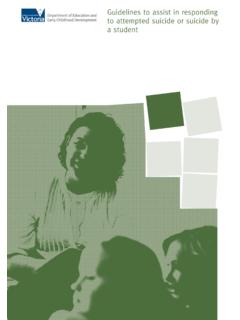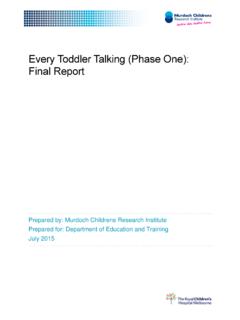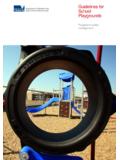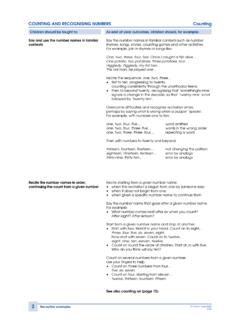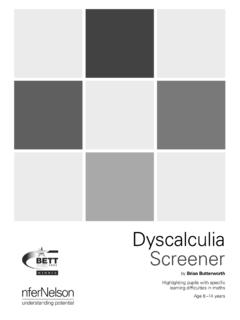Transcription of THERE’S MORE TO COUNTING THAN MEETS THE …
1 Di Siemon/SWARM 2/Janueary 9, 2007 Page 1 THERE S more TO COUNTING than MEETS THE EYE (OR THE HAND) One of the main aims of school mathematics is to create mental objects in the mind s eye of children which can be manipulated flexibly with understanding and confidence. A prolonged reliance on inefficient strategies such as make-all-count-all or COUNTING -by-ones is both developmentally dangerous and professionally irresponsible. A paper prepared by Dr Dianne Siemon, Associate Professor of Mathematics Education, RMIT University .. NUMBER SENSE refers to a person s general understanding of number and operations along with the ability and inclination to use this understanding in flexible ways to make mathematical judgements and to develop useful and efficient strategies for managing numerical situations. It results in a view of numbers as meaningful entities and the expectation mathematical manipulations and outcomes should make sense.
2 Those who use mathematics in this way continually utilise a variety of internal checks and balances to judge the reasonableness of numerical outcomes (p3). McIntosh, A., et al (1997) Number Sense in School Mathematics - Student Performance in Four Countries, Perth: MASTEC DEVELOPING A SENSE OF NUMBER What is needed? An understanding of number and operations together with an ability and inclination to use this in flexible ways to make mathematical judgments to develop useful strategies for handling numbers to communicate, process and interpret information. McIntosh, A., Reys, B. & Reys, J. (1992) A proposed framework for examining basic number sense, For the Learning of Mathematics, 12(3), 2-8 Three essential underpinnings: (i) NUMERATION (PLACE-VALUE) An understanding of numbers and an ability to think of them in more than one way (rename numbers). (ii) MEANING FOR THE OPERATIONS (CONCEPTS) An understanding of what the operations do, an ability to recognise the operation symbols and an ability to write and interpret symbolic statements.
3 (iii) MENTAL STRATEGIES (NUMBER FACTS) A working knowledge of addition and subtraction facts to 20 and multiplication and division facts to 100, based on efficient non- COUNTING , mental strategies. Reference: Booker, G., Bond, D., Briggs, J. & Davey, G. (1997) Teaching Primary Mathematics (2nd Edition), Longman Cheshire: Melbourne Last updated: May 2008 State of Victoria (DEECD), 2008 Di Siemon/SWARM 2/Janueary 9, 2007 Page 2 Four essential aspects: FOCUS ON SPEAKING Encourage children to invent and present action stories, count aloud, explain their solutions, model and acknowledge more efficient strategies. FOCUS ON LISTENING Model more efficient COUNTING strategies, count on from larger, skip COUNTING (small numbers only), count to support place-value, eg, onety-two, onety-three ..twoty-one, twoty-two, ..threety-five, FOCUS ON READING Read physical collections, models, displays, adopt a say what you see approach, practice subitisation, ie, say how many without COUNTING , teach children to read numbers, eg, 367 can be read to the tens place as 36 tens and 7 ones.
4 FOCUS ON WRITING Explore informal writing. Delay initial recording until children have access to mental strategies, expect non-modelled solutions. RECOGNISE THAT EARLY NUMERATION INVOLVES more than COUNTING While the ability to count is important, children need to know much more before they are ready to use numbers flexibly, with understanding. NUMERATION INVOLVES: One-to-one correspondence Recognising that three means a collection of three whatever it looks like. Recognising that the last number counted represents the number in the collection Matching words and/or numerals to collections less than 10 (knowing the number naming sequence). Reading, writing, and using the words and numerals for the numbers 0 to 9. BUT more IMPORTANTLY IT INVOLVES: Recognising collections of up to five objects without COUNTING (subitise). Being able to name numbers in terms of their parts (part-part-whole).
5 Trusting the count (Willis, 2000) ESTABLISH PART-PART-WHOLE IDEAS FOR NUMBERS 0-10: Using a Ten Frame, for example, 6 and 1 more , 1 and 6 7 is 1 less than 8 5 and 2, 2 and 5 double 3 and 1 more 3 and 4, 4 and 3 0 and 7 Last updated: May 2008 State of Victoria (DEECD), 2008 Di Siemon/SWARM 2/Janueary 9, 2007 Page 3 Use visual recognition activities involving collections, games and the use of Ten-Frames, for example, Make a permanent Ten-Frame on a white-board or felt board. Use with different numbers to review what is known and extend to new numbers. Make a frame for each number on a large poster, hang it in the classroom and add relationships as children discover them. Make a class book for each number based on part-part-whole ideas. Make a frieze for the classroom. Make a set of number cards for the numbers 0 to ten.
6 One set each for numerals, words, collections, different ten frames, and part-part-whole relationships (5 different sets in all). Play collection games, concentration, Snap etc Have children sit at tables of ten arranged in pairs like a Ten-Frame. Ask: How many at the table? Send an A3 version of a Ten-Frame home to be used with fridge magnets. Encourage all members of the family to say what they see and why. Make a playground version of a Ten-Frame - have children jump in and out of the frame to make a given number in as many ways as they can. ESTABLISH DOUBLES FACTS TO 20, EXPLORE more EFFICIENT STRATEGIES: Use 2 ten-frames, 2 rows of a bead frame or a double-decker bus model to develop and extend doubles knowledge, devise number stories, explore strategies. INTRODUCE & CONSOLIDATE PLACE-VALUE IDEAS INTRODUCE PLACE-VALUE: Introduce the new unit - that is, ten ones is 1 ten via bundling and COUNTING tens, eg, 1 ten, 2 tens, 3 tens, 4 tens.
7 Introduce the names for multiples of ten - language only, no symbols Make, Name and Record numbers 20-99 using appropriate models - eg, make 6 tens 3 ones , read and write sixty-three , record using a place-value chart Make, Name and Record numbers 10-19, pointing out inconsistency in language (should be onety-seven, onety-eight etc) Consolidate place value knowledge REINFORCE PLACE-VALUE THROUGH REGULAR ACTIVITY: Make, Name, Read and Record numbers using appropriate models Compare two numbers - Which is bigger? Why? How do you know? Order and Sequence numbers Count forwards and backwards in place-value parts RENAME numbers in as many different ways as possible Last updated: May 2008 State of Victoria (DEECD), 2008 Di Siemon/SWARM 2/Janueary 9, 2007 Page 4 DEVELOP MENTAL STRATEGIES FOR ADDITION & SUBTRACTION FACTS TO 20 (oral not written) 1.
8 COUNT ON FROM LARGER (for combinations involving 1, 2 or 3) eg, seven and two (7 and 2) seven .. eight, nine three and six (3 and 6) six .. seven, eight, nine one and eight (1 and 8) eight .. nine two and nine (2 and 9) nine .. ten, eleven 2. DOUBLES & NEAR DOUBLES eg, 4 and 5 four and four is eight, one more , nine 8 and 7 eight and eight, sixteen, one less, fifteen 6 and 7 six and six is twelve, one more thirteen 8 and 9 double eight, sixteen, one more , seventeen 3. MAKE TO TEN & COUNT ON eg, 4 and 7 seven, ten, eleven 8 and 6 8 .. 10, and four more , 12 7 and 5 7 .. 10, and two more , 12 4 and 9 9 .. 10, and three more , 13 4. EXTEND STRATEGIES TO SUPPORT SUBTRACTION eg, 9 take-away 3 nine .., eight, seven, six (count-back, 1, 2 or 3 only) 14 take-away 8 14 .. 7 (halving), 6 (halving) 16 take-away 9 16.
9 10, (take three more ), 7 (make back to ten) 12 take-away 5 think, 5 and what is 12?, 5 and 7 (think of addition) 5. DEVELOP STRATEGIES FOR RELATED FACTS eg, 3 tens and 5 tens , six, seven, eight tens 14 tens take 8 tens 8 and what is 14? .. 6 tens 36 and 7 43 because 6 and 7 is 13 INTRODUCE INITIAL RECORDING AS STRATEGIES ARE ESTABLISHED eg, 2 Think: 8, 9 6 Think: double 6, 12, and 1 more , 13 + 7 + 7 6 Think: 8 .. 10, and 4 more , 14 + 8 INTRODUCE FORMAL RECORDING TO SUPPORT PLACE-VALUE IDEAS DEVELOP RECORDING STRATEGIES TO SUPPORT MENTAL COMPUTATION Last updated: May 2008 State of Victoria (DEECD), 2008 Di Siemon/SWARM 2/Janueary 9, 2007 Page 5 INTRODUCE AND EXPLORE THE USE OF THINKING STRINGS : eg, 35 and 76? Record and analyse: 76, 106, 111 you started with the larger, added 3 tens then 5 more 35, 40, 41, 111 you made to nearest ten, then added 1 more , then 7 tens 11, 81, 111 you added ones, then 7 tens and 3 tens more EXTEND RENAMING TO DEVELOP SAME AS STRATEGY: eg, 57 take-away 29?
10 SAME AS: 58 take-away 58 take 3 tens, 28 Advantage of single step, avoids multiple steps and tendency to add or subtract incorrectly when rounding numbers and adjusting at a later stage. EXTEND VISUAL COUNTING STRATEGIES: eg, three addends, no recording (inspection only) 24 56 6 ones and 4 ones is 1 ten 5 tens and 2 tens is 7 tens so 8 tens altogether 72 sum? Add 7 tens, 15 tens, 150 and 2 more ones is 152 Use the same idea for subtraction by including the total in the shaded area and omitting one of the addends. eg, missing addend, no recording (inspection only) 43 17 132 take 1 ten is 122, take 7 is 120, 115 115 take 4 tens (THINK: 11 tens, take 4 tens is 7 tens), 75 ? 132 75 take away 3 ones, 72 Can you think of another way? INTRODUCE MULTIPLICATION & DIVISION IDEAS (through action stories and modelling) Last updated: May 2008 State of Victoria (DEECD), 2008 Di Siemon/SWARM 2/Janueary 9, 2007 Page 6 Use action stories involving groups of and arrays to explore concepts Model more efficient COUNTING strategies, such as skip COUNTING (small numbers only) Encourage children to invent and represent their own action stories.
